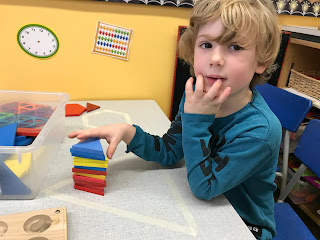Thank you SO much for jumping on board the borrow-a-book program. I can tell, through my daily meetings with each reading group, that you are not only doing the job, but also making it fun for the kids. They have been very proud to read their books with me the next day, and eager to exchange them (I have to talk them out of whipping out their books before their meeting with me!).
I know that there will be days when it doesn't get done, but let's keep giving it our best effort. I think we will all be blown away by the kids' progress!!
The first two reading strategies that we are emphasizing with our beginning readers are:
- looking at the pictures - this will often be enough to guess a word, for example in those colour books
- noticing a word pattern - this is why you read the first page - after this, many readers notice that the words look the same on each page, and it helps them keep going. I've worked with older readers who missed out on using this strategy, so I wanted to start with it right away.
With the excitement of our trip, and the need to explain borrow-a-book, I've delayed telling you about some exciting math stuff that's happened over the last while. It's always exciting when students do something in their independent centre time, that leads us to a group learning opportunity. Recently, we have been inspired by the students' enthusiasm for building with shapes, and counting, so we have set up some activities to extend upon their interests.
Since we have been counting aloud in French quite a bit, I decided it was high time to begin matching up the numbers that we say with how they actually look. Pictured below, we gave each student the challenge of representing their number with stickers, in a way that was easy to count. You can see that many students used the idea that Sean suggested - to use rows, some students lined them up, and Nora put her stickers in the shape of her number.
These beautiful posters will be a great reference tool for us!
On another day, during centre time, I was presented with a pizza made of big and small magnetic triangles. The cook didn't know the amazing geometry and measurement that she had done in creating this pizza. Not only was she exploring shapes (using triangles to build a hexagon), but was also able to measure the surface area of the pizza in two ways - it took 6 large triangles, or 24 small triangles. We looked at the pizza as a class, and talked about how it takes many small items or few large items to cover the same area.
Later, we set up an extension activity for the class and many mathematicians tried their hand at building shapes using other shapes, and were able to fill in my outlines in more than one way.
(Thanks Lori, for sharing the resource with this idea!)
While it was still snowy, we had fun shoveling, tobogganing and building with it. This group worked together to make the cutest little snowman - coming up with solutions to the problem of the snow not being very sticky.
In the picture below, some scientists found our magnetic wands, and I encouraged them to look and test for other magnetic items in the classroom. They found the items that immediately came to my mind, as well as some that I didn't think they'd check, and others that I didn't even think of, like the drying rack!
These are great examples of what learning through play looks like!











